 |
| While Revell had worked on the Finnish pavilion at the World Exhibition in Paris, his greatest achievement was in winning the competition Toronto's city council had set forthfor the design of its new Hall. |
|
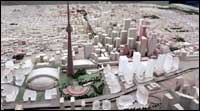 |
THE BUILDING For
decades there had been talk of a new town hall at the forefront of political
discussions. The old building could not keep the pace with the ever-growing
population of Toronto. The creation of a new hall was very important to
the developing metropolitan area of Toronto and people didn't want it
to be overshadowed by commercial buildings. It should be a building that
offered presence in an ever-growing town, in essence, a focal point. |
A scale model of Toronto, including the new City Hall |
|
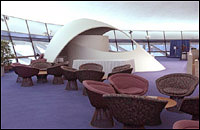 |
Revell had a way of making this happen, and out of 520 competitors, his idea for City Hall was chosen. His remarkably modern design, in that time period, would put Toronto on the map, and be worth thousands in tourism. The building he designed
was unlike anything people had ever seen before, which may be why it was
once used during the filming of a "star-trek" episode. Seen
from above, the Toronto City Hall is much like an eye between two eyelids.
|
This is an example of modern design that would look futuristic on the set of "Star Trek" |
|
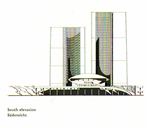 |
The building is separated into three parts. The central part is the city council's chambers, which is a round, saucer-like structure. This structure is enveloped by two office towers, of differing heights, which curve and resemble two half circles. This is an important shape to note, because, in Finland, the eye represents democratic ruling.
|
| Cross section of the building plan (south elevation) | |
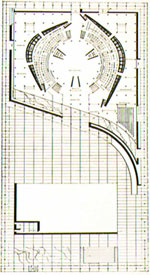 |
There were many controversies that surrounded the building of City-Hall from the beginning of its development. The site chosen for the building was a problem in itself. To clear space for the new structure, two older, but well-known buildings would need to be demolished. The product of this event was a conflict amongst Torontonians who vied for the architectural past of the city and those who wanted to develop. There were other problems as well. Two judges did not agree with Vilo winning the competition and wanted to consider other submissions, and space needed to be rented out in the building to compensate one that was to be demolished. The site was also home to Toronto’s first China Town, and many people would need to be evicted. However, even with all the controversy surrounding its creation, all this could be considered normal public discussion for a building so well known. Toronto’s new
city hall became a landmark for the ever-growing metropolitan area. Its
futuristic/modernist design captured the attention of people across the
globe, gathering publicity for the new city in Canada. It could even be
argued that Viljo’s Toronto City Hall was the key in its flourishing
success. |
| Aerial view of the site plan | |
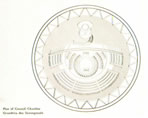 |
The building, estimated to cost $7 million in the beginning, skyrocketed to an eventual $31 million. In September, 2:00 p.m. on
September 13, 1965 the Toronto City Hall opened. |
| Plan for the circular council chamber |
| Site designed by Kaitlyn Watson and Kate Legge Design 11, Horton High School May 2005 |